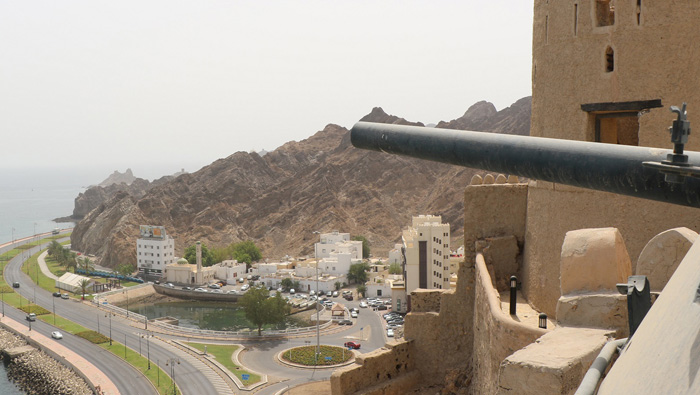
Muscat: As part of its efforts to further boost tourism in the Sultanate, the Ministry of Tourism plans to rope in companies with expertise in the management of historical sites.
Having opened the first phase of the historic Muttrah Fort in Muscat for tourists after renovation, the Ministry of Tourism is also trying to attract experienced and specialised companies to manage Fort and the Big House or Al Bait Al Kabeer located just below the fort.
It has also called for investments in these sites. The historic Muttrah Fort overlooks the Sultan Qaboos Tourism Port, Souq Muttrah and neighbouring tourist spots.
Abdullah bin Salem Al Thahli, Assistant Director General for the Development of Tourism Sites and Products, said: “The idea behind using Muttrah Fort for tourism is part of the vision of the Ministry of Tourism to develop the forts of the country as tourist destinations.”
He said the fort has strong defence elements and a unique architectural design, which is why the ministry wanted to highlight these elements and develop it as a tourist destination in the first phase, and in the second phase, begin the development of the adjoining areas.
Tourist attraction
Al Thahli said the fort was one of the most important projects taken up by the ministry to turn it into a major tourism and cultural attraction, as its unique urban architectural area could attract tourists from inside and outside the country.
He said the fort had a variety of old cannons. The history of each cannon differs. There is history behind the manufacturing of each cannon and there are details about the country where they were manufactured.
There are Omani, Portuguese, British, French, American, Indian and Persian cannons. Some of them are for ground battle, some of them for naval ships, and some for permanent buildings such as forts. There are brief notes about their history, use and military significance.
Al Thahli said the Ministry of Tourism has made huge efforts to develop this landmark as a major tourist attraction as it believes in its significance. It wanted to put it on the tourist map.
The ministry worked with a scientific vision and rules and methods of archaeological development, without blurring the original characteristics and features of the fort.
He said the ministry’s development plan ensured comprehensive maintenance of the fort to preserve it as an archaeological site, while maintaining its
originality.
While working on this project, a comprehensive scientific analysis of the building materials was done to ensure its protection from erosion and corrosion.
It was also important for damage caused by pests, insects and fungus in the roofs and windows to be repaired.
Surrounding area
He said the area around the fort has been developed on the principles of urban design meant for dealing with the surroundings of historical sites, which has facilities for tourists, cultural and artistic activities and investment opportunities around it.
“The forts are unique architectural pieces of art, which prove the richness of Omani heritage and highlight craftsmanship,” said Al Thahli. He said that Omani heritage was rich in architectural features, which could be seen in the military architecture of towers, religious architecture of mosques and civil architecture such as houses, souqs and old lanes.
It shows the fort was a unique example of the architectural heritage of the region. This heritage includes many monuments, which highlight architectural styles and the Omani artistic environment with Islamic characteristics, simplicity of design, decoration and the beauty of the buildings. It shows the history of the place and gives a sense of deep-rooted local culture, customs and traditions and social norms. It has its own natural environment of unique mountains, wadis, climatic and topographical characteristics.
Sultan bin Jameel Al Mukhmari, Acting Director of the Department of Historic Sites Development, said that the idea behind the rehabilitation of the fort of Muttrah included the development of the area below the fort. It includes a parking lot and reception. The ministry is also trying to purchase the properties located below the fort from their owners, so that the fort would have its own parking lot for visitors with a capacity to accommodate 28 cars. It is also developing toilets and accommodation for the guards. It is also working on the development of a lobby at the main entrance and getting rid of dilapidated roofs. It is also renovating and altering the current water system, which obstructs traffic routes inside and outside the fort.
Al Makhmari said that the comprehensive maintenance of the interior and exterior parts of the castle has been completed. Now, there is modern interior and exterior lighting, which is in line with the historical nature of the fort. The rehabilitation of all floors, surfaces and stairs leading to the fort has been done. All the woodwork in the fort has been restored. This includes doors, windows and wooden ceilings. The damage caused by moisture and termites was also treated and other preparations were made to welcome tourists to the fort.
The approach
Visitors to the fort of Muttrah can reach the area by car via Souq Muttrah towards the office of Wali Muttrah, and then turning right towards the fort.
Timings
The castle will open its doors to visitors throughout the week as follows:
Saturday to Thursday from 9am to 4pm
Friday from 9am to 11am and from 2pm until 4pm.